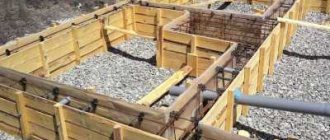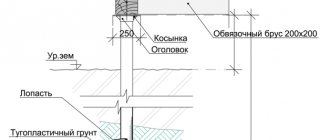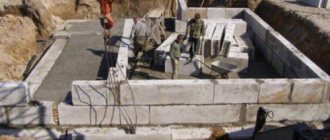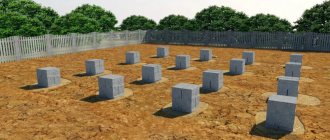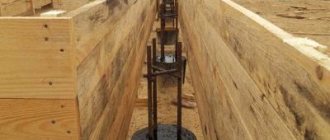Characteristics of PVC pipes
The dimensions of PVC tubes for formwork structures are regulated by state standards. The choice of a specific product, as well as their quantity, depends on the thickness of the floor for which it is planned to fill with liquid concrete. Note that due to their strength properties and operational parameters, polyvinyl chloride tubes can be used repeatedly. It is not very difficult to remove the product from finished formwork structures of medium and small thickness.
Generally accepted building codes consider a PVC pipe of the following dimensions to be standard:
- length - no more than 3 meters;
- wall thickness - from 1.6 to 2.4 mm;
- diameter - from 16 to 63 mm.
The convenience of using PVC tubes for formwork lies not only in their high strength characteristics and the possibility of repeated use. To install and remove the product, no serious preparatory measures are required; the required size can be easily measured and cut with an ordinary construction knife. They can be stacked, left for long-term storage and transported without the risk of deformation or change in strength properties. In addition to the PVC pipes themselves, the delivery package should include special plugs and clamps.
Agriculture:
We supply technical PVC pipe with a diameter of 25mm to several greenhouses in the Moscow region. From sections of this pipe, which are connected through special transitions, long lines are made up, which are under constant (small) pressure, about 2-3 atmospheres. Thanks to this pressure, through adapters - valves, PVC pipe lines constantly wet the soil with water.
Packaging dimensions of PVC pipes manufactured by us:
- We mainly make 2m and 3m rods.
- Packages of two-meter whips of 100 meters. (fifty whips), pack diameter 300mm.
- Packages of three-meter whips of 120 meters each. (forty whips), pack diameter 250mm.
- One cubic meter contains approximately 1500 meters of PVC pipe with an outer diameter of 25 mm.
We can make pipes of any length to order.
Features and benefits of tubes
PVC pipes have a lot of advantages that make them an indispensable attribute in modern construction. The main ones are:
- convenience and ease of dismantling formwork structures;
- creation of the necessary formwork configuration that fully complies with the standards;
- high resistance to aggressive environments, fire and moisture;
- protection of metal formwork elements from corrosion and aggressive environmental influences;
- possibility of repeated use;
- do not require special conditions for storage and transportation.
There are no significant disadvantages to polyvinyl chloride tubes. But it should be noted that they should not be left for long periods of time in direct sunlight or subjected to strong mechanical stress. As a result of improper handling, deformations, bends, etc. may occur on the product. Damaged tubes with visible mechanical damage, cracks and irregularities are prohibited from being used when installing formwork structures for safety reasons.
Separately, it is necessary to mention the locking cone. This is an additional element-tip of the structure, which is used to ensure that the liquid concrete mixture does not get into the internal cavity of the PVC tube, thus rendering it useless. It consists of a body and a skirt, and its size is selected based on the diameter of the tube that you plan to use.
Everything with your own hands
Today we wanted to pay special attention to formwork screed and answer common questions: why do you need to screed the grillage (foundation) formwork, how and what to make it from, when to remove it, and, of course, how much does it cost to screed the formwork yourself.
To begin with, I would like to note that when studying this issue, we came across quite a lot of messages and comments on the Internet, how when pouring the foundation (grillage) with concrete, the formwork simply came apart at the seams or gave such cracks, which led to very unpleasant results. It was necessary to restore the desired structure, give the foundation the desired shape and re-fill the concrete. And this, of course, is a loss of energy, time and money, which is already lacking in our lives...
Why do you still need to screed the formwork under the grillage (foundation)? It is necessary to reduce the pressure on the formwork when pouring concrete mixture into it. Thus, the formwork becomes stronger due to the distribution of the load between the parallel sides of the formwork and the screed. The absence of a screed can lead to collapse or expansion of the formwork walls, and thereby compromise the integrity of the structure being poured with concrete.
After we made the reinforcement frame for our grillage of the future foundation with our own hands and moved on to making the formwork, we were faced with the question of screeding it. In principle, we quickly decided that we would tighten the formwork using homemade tension screws or pins, so we decided to talk about this method and our experience with it.
To screed our removable formwork we needed:
— galvanized rod DIN 975, 2 meters, diameter 12 mm, price 152 rubles. for 1 piece, 80 pieces for the amount of 12,160 rubles.
- rigid PVC pipe, 2 meters, diameter 16 mm - price 11 rubles. for 1 piece, 88 pieces for the amount of 968 rubles.
— galvanized washer, 12 mm. for the amount of 500 rubles. (sold by weight)
— galvanized nut, 12 mm. for the amount of 900 rubles. (sold by weight)
Rods (studs) and PVC tubes for screeding formwork.
Of course, everything was taken with some reserve, so the amounts and quantities are approximate.
The total cost of screeding the formwork with our own hands was approximately 14,500 rubles. A huge advantage of our screed is that, despite its expensive cost, it will have a so-called “second life”, but more on that a little later...
So, how did the process of screeding the formwork take place? The first thing we needed to do was cut the rods (or in other words, studs) and PVC pipes. The length of the pins was 50 cm, the length of the tubes was 35 cm. In order to save time and effort when measuring these products, we came up with the following design. We place a homemade wooden table next to the vertical stop at the distance we need, respectively, for studs 50 cm, for tubes 35 cm. Then on the table we install a holder made of pieces of wood for a rod or tube perpendicular to the vertical surface, insert the desired element into the holder and saw it off. Our device can be seen in the photo below.
Homemade table for cutting pins and PVC pipes.
After the preparatory work came to an end, we moved on to the installation and installation of wooden formwork, and then to its screed. For reliability, we made screeds approximately every 50 cm in 2 rows, 10 cm away from the corners. First, markings were made with a marker, then we drilled holes with a drill, after which we pulled together the entire formwork. First of all, metal rods with PVC plastic tubes on them were inserted, then the structure was fixed using washers (on both sides) and nuts (only on the outside). For general reliability of the formwork, metal corners were installed in the corners. What we came up with can be seen in the photo below.
Screeding the formwork with studs.
We would like to boast that the pouring of the grillage went off with a bang. The formwork easily withstood the entire load, no cracks or discrepancies appeared.
Already 3 days after pouring the concrete, we removed the screed, and then the grillage formwork itself. For the foundation we used concrete grade 350, it hardens quite quickly, which is why the demoulding time is so short. The process of removing the screed is quite simple, although some questions arise about it. We will answer the most popular one right away. Yes, plastic PVC pipes remain in the concrete and do not go anywhere. But the rods (studs) are simply knocked out of the foundation.
As you already understood, the most expensive part of screeding formwork are the very studs on which we spent most of the budget. We initially did not want to rent screeds, because... We had our own plans for the bars. After we had them as screeds, we confidently put them aside intact and safe until the next use, namely for interfloor reinforcement. So all the materials are used, nothing extra will be left in the construction of the house with your own hands =)
By the way, our video on the YouTube channel is already ready, so we invite you to watch it and see in reality what formwork screeding, its installation and dismantling looks like. Enjoy viewing and look forward to your comments and suggestions, questions or feedback.
Best wishes,
Yana and Zhenya Shigorev
Plastic elements for formwork and reinforcement
| vendor code | product name | Photo, drawing | Description | Package | |||||||
| PVC pipe 25/1.5 (no color requirement) Inner diameter 22 mm; Outer diameter 25 mm | PVC pipe for the monolith is produced in three meter lengths. Directly at the construction site it is cut into the required size, which determines the thickness of the wall being built. Protects the clamping screw from the ingress of concrete mixture. Minimal discrepancy in internal diameter is allowed. With this type of pipe included, we recommend taking a cone clamp made specifically by us. The pipe is a consumable material and remains in the concrete body. Outer diameter: 25 mm -0.03 Inner diameter: 22 mm -0.03 Length: 3 meters Material: Polyvinyl chloride Method: Extrusion Packaging: Bundle Quantity per package: 40 pieces Package weight: 17.8 kg PVC pipe 25/1.5 (color gray) Inner diameter 22 mm; Outer diameter 25 mm PVC pipe is produced for use in monolithic construction and for laying electrical wiring. Ideally maintained size along the entire length of the pipe. Available in three meter lengths. Cut to the required size directly at the construction site. The length of the pipe section determines the thickness of the wall being built. Protects the clamping screw from the ingress of concrete mixture. A cone clamp is installed at the ends of the pipe. The pipe remains in the concrete body and is a consumable material. Outer diameter: 25 mm Inner diameter: 22 mm Length: 3 meters Material: Polyvinyl chloride Method: Extrusion Packaging: Bundle Quantity per package: 40 pieces Package weight: 19.2 kg HDPE pipe 25/1.5 (black) Inner diameter 22 mm; Outer diameter 25 mm HDPE pipe for monolithic construction and electrical wiring is produced in three-meter lengths. Recommended for use in winter. Due to more expensive material and technical parameters, the pipe has high impact strength at low temperatures. It does not prick or crack when cut into the required size. Protects the clamping screw from the ingress of concrete mixture. A cone clamp is installed at the ends of the pipe. The pipe is a consumable item. After removing the tightening screws and cones, it is recommended to plug the hole with a 22 mm plug. Length: 3 meters Material: Low-density polyethylene Method: Extrusion Packaging: Bundle Quantity per package: 40 pieces Package weight: 18.2 kg Spacer cone 150 (300) | The spacer cone is used to protect the tension screws from the ingress of concrete mixture. Unlike PVC pipe, the Spacer Cone is a reusable product. They are removed using a special tool. The product is joined together, which helps to achieve the required thickness of the wall being built. Load when pouring more than 8 tons. Outer diameter: 40-55 mm Inner diameter: 25-40 mm Material: Polyamide Packaging: Bag Package quantity: 50 pieces Package weight: 11.4 kg Spacer cone 160 (320) | Outer diameter: 40-55 mm Inner diameter: 25-40 mm Material: Polyamide Package: Bag Packing quantity: 50 pieces Weight of packing: 12.5 kg Spacer cone 180 (360) | Outer diameter: 40-55 mm Inner diameter: 25-40 mm Material: Polyamide Package: Bag Packing quantity: 50 pieces Weight of packing: 14 kg Spacer cone 200 (400) | Outer diameter: 40-55 mm Inner diameter: 25-40 mm Material: Polyamide Package: Bag Packing quantity: 50 pieces Weight of packing: 15.6 kg Spacer cone 220 (440) | Outer diameter: 40-55 mm Inner diameter: 25-40 mm Material: Polyamide Package: Bag Packing quantity: 50 pieces Weight of packing: 16.5 kg Spacer cone 250 (500) | Outer diameter: 40-55 mm Inner diameter: 25-40 mm Material: Polyamide Package: Bag Packing quantity: 50 pieces Weight of packing: 18.1 kg Special tool for removing the spacer cone. Material: Metal Packaging: Piece Quantity per package: 1 piece Package weight: 1.5 kg | Prevents the possibility of concrete getting inside the protective tube. Ensures a tight fit of the PVC or HDPE tube with the formwork surface. The diameter of the retainer skirt determines the area of contact of the product with the formwork. Reusable. Skirt diameter: 42 mm Packaging: Bag Quantity per package: 1000 pieces Package weight: 4.9 kg Cork 22 (side) Acts as a plug in the pipe after removing the formwork and removing the cone retainer. Closes technological holes in some types of formwork. Packaging: Bag Quantity per package: 1000 pieces; 5000 pieces Package weight: 2.5 kg; 12.5 kg Stopper 22 (cone-shaped) Acts as a plug in the pipe after removing the formwork and removing the cone retainer. Closes technological holes in some types of formwork. Packaging: Bag Quantity per package: 1000 pieces; 5000 pieces Package weight: 3.094 kg; 15.5 kg Cork 24 (side) Packaging: Bag Quantity per package: 1000 pieces Package weight: 2.7 kg | Closes technological holes in some types of formwork. Outer diameter: 22-25 mm Packaging: Bag Quantity per package: 1000 pieces Package weight: 2.5 kg Protective cap for fittings (cone-shaped) | Designed to prevent reinforcement from breaking through waterproofing during vertical reinforcement. For protecting the ends of reinforcement in precast concrete forms. Reinforcement diameter: up to 16 mm Packaging: Bag Quantity per package: 1000 pieces Package weight: 13 kg Reinforcement protection cap Type 1 (8-16) | The protective cap in our company's product range is presented in two types. Because of its similarity, type 1 cap is called an hourglass. Cap type 2 mushroom. Both types are designed to prevent injuries on construction sites. When making products, a bright color dye is added to the material. The ends of the fittings pose a risk of injury, and the orange color of the caps alerts builders to the danger. Reinforcement diameter: up to 16 mm Reinforcement used: from 8 to 16 mm Packaging: Bag Quantity per package: 500 pieces Package weight: kg Protective cap for fittings Type 1 (16-30) Reinforcement diameter: up to 30 mm Reinforcement used: from 16 to 30 mm Packaging: Bag Quantity per package: 500 pieces Package weight: kg Protective cap for fittings Type 2 (8-16) Reinforcement diameter: up to 16 mm Reinforcement used: from 8 to 16 mm Packaging: Bag Quantity per package: 500 pieces Package weight: 5.1 kg Protective cap for fittings Type 2 (16-30) Reinforcement diameter: up to 30 mm Reinforcement used: from 16 to 30 mm Packaging: Bag Quantity per package: 500 pieces Package weight: kg Dear our clients and site visitors! All photographs that are the property of LLC PC "Empire of Metal and Plastic" presented on the site are in the public domain and can be copied and posted on any other sites and platforms, to which we give you our consent! Our motto: Openness is the key to success! |
Comments
03/24/2016 22:44:20 Dmitry An
Thank you, everything is clearly stated. I think plastic pipes are somehow more reliable than making formwork from roofing felt. Although more expensive. It is cheaper to use gray pipes for internal sewerage.
Answer
03/24/2016 22:44:40 Alexander
Good afternoon My question is this: the diameter of the pipe is 110 mm, we will insert a reinforcement frame into it, let the side of the square be 60-80 mm. Will it be possible to fill this with high-quality concrete and crushed stone? How will it get through the reinforcement there? Will it get stuck, will there be any unnecessary cavities? Will it hold if you make it without crushed stone, just C+P+V?
Answer
03/24/2016 22:44:53 Maxim Gvozdev
It will be very difficult to bayonet concrete with crushed stone in such a pillar. And it cannot be done without voids, which will lead to a decrease in the strength of concrete. Sand concrete is used quite often and, according to reviews, it copes with its task quite well. If you make concrete yourself, then you need coarse sand. It's up to you to decide. Here is a clipping from the magazine: As already explained, heavy concrete aggregates are introduced to save cement. A concrete mixture in which only sand serves as filler may be more acceptable for many developers. The high cost of crushed stone, the complexity of dosing the mixture and the increased likelihood of its delamination are not in favor of heavy concrete. Recently, sand concrete without heavy aggregates has become widely used in industrial construction. Lvovich K. Sand concrete: homeland - Russia. - M.: NIIZhB. Stroyinform, 2001.
Answer
03/24/2016 22:45:11 Alexander
Thanks for the answer! Is it possible to add an option to calculate concrete without coarse aggregate to the calculator? Everything there is done so well, I would like to use it in calculations without crushed stone.
Answer
03/24/2016 22:45:20 Maxim Gvozdev
Alexander, thank you. I also wanted to implement this feature in the calculator. I just haven’t found any SNiPs or GOSTs for fine-grained concrete yet. Purely theoretically, it is possible to subtract crushed stone from concrete and make the calculation without crushed stone. But I still want to find at least laboratory data on such concrete. There is only documentation for preparing the solution.
03/24/2016 22:46:04 Seryoga
Hi all. Guys, is it really possible to find a plastic pipe with a diameter of 200 mm? in all stores they say that the maximum is 160 mm.
Answer
03/24/2016 22:46:20 Maxim Gvozdev
Seryoga, can you find 200mm pipes for external sewerage? It seems like it was a popular product...
Types of studs
There are two types of tie rods for formwork:
- type A. The product has the same dimensions in the threaded and smooth parts;
- type B. The product has a smaller diameter of the smooth part and an increased diameter of the thread.
In addition to metal pins, other product options are used when assembling formwork, in particular:
- fiberglass coupling screws. These products are characterized by low thermal conductivity and low shear resistance. As a rule, these products are disposable; they are cut off when dismantling the structure and left in the concrete;
- plastic screed for formwork has an affordable price. A regular plastic screed is used to assemble molds for casting structures with a width of no more than 250 mm. When assembling forms for thicker walls (up to 500 mm), a plastic extension is used simultaneously with the screed.
Possible errors during construction and ways to correct them
To keep the pipes securely at their level, a high-quality cushion is placed under them . When working with particularly mobile and loose soils, it is advisable to also place a stone platform under the cushion. If this is not done, the pillars may begin to fail.
In such cases, a tunnel is made under their base, after which a strip support is constructed. Or they raise the pillars to the required level, and then fasten them with reinforcement.
If the number and diameter of supports are incorrectly calculated, and the foundation cannot properly support the building, the process of deformation and destruction of the walls will begin. In such cases, it is necessary to dismantle and strengthen each support.
You will find a lot of important and useful information about columnar foundations here.
Instructions for constructing a columnar foundation from plastic pipes
We bring to your attention instructions for installing a columnar foundation made of plastic pipes (PVC). You can study more detailed instructions in the article: Do-it-yourself columnar foundation.
Work plan
1. Design of a columnar foundation. Calculation of the number of pillars, their location, depth of placement in the ground.
Detailed instructions for marking the foundation can be read in the article: Marking for the foundation. Rules for constructing a rectangular foundation. For a columnar foundation: Marking for a columnar foundation with a grillage.
Calculator Stolby-Online v.1.0 – design of a columnar foundation.
2. Preparatory work.
We prepare formwork from plastic pipes of the length we need. If we make a pillar with a widening, then we place a garbage bag at the bottom of the pipe and fasten it to the formwork with tape. This package will serve as a reservoir for filling the heel of the pillar.
Areas of use
Formwork pins are used to connect formwork panels in a parallel manner, holding the pushing concrete mass together. It should be noted that such formwork fasteners absorb a significant portion of the created pressure. Today, this option for securing a concrete structure is considered the easiest to implement and most reliable.
The foundation stud must be able to withstand maximum loads, and for this reason, high-quality steel is used to make it.
Advantages of foundations made of PVC plastic pipes:
All installation work with PVC pipes is possible on your own; there is no need to involve heavy special equipment, equipment and crews. To install the most common type of foundation for frame and lightweight houses - columnar - there is no need to perform large volumes of excavation work. According to technology, bored foundations are considered one of the simplest, and are used for any foundation soil, including problematic ones - heaving, weak, waterlogged, bulk When building on a site with complex terrain, slopes, drops, pile foundations are also successfully used. The technology does not require large-scale excavation work; all actions can be performed in the immediate area of the building.
If there are buildings nearby, the site is saturated with underground utilities, the root system of nearby green spaces must not be damaged, then a pile foundation made of pipes will also be a practical solution. A foundation made of pipes allows you to vary the height of the building above ground level with a minimum of additional financial investments, as needed. For areas flooded by floods or high water in the spring, this is an important advantage. The necessary pipelines and utilities can be laid under the building. In terms of construction time, this foundation is one of the fastest. It is possible to cut pipes of the required length using ordinary household tools, without additional equipment. The cost of this foundation is more than doubled.
The advantages of polyvinyl chloride over other building materials are absolute neutrality to the aggression of the natural environment, to chemicals contained in soils, to water - no waterproofing is required. Plastic also does not need thermal insulation, since PVC does not experience temperature deformations under operating conditions in the ground. Thus, there is no need to purchase insulating materials for the foundation, and in addition, transportation of lightweight plastic pipes is significantly cheaper.
Stud for formwork - features of the work
When pouring monolithic structures, builders use formwork, without which this type of work cannot be performed. It is the formwork structure that gives the concrete mass the necessary shapes and parameters. To prevent the panels from falling apart under the pressure of the mortar mass, they should be securely fixed. Experts recommend using special devices called “formwork pins.”
Disadvantages of using PVC pipes for pile foundations:
- Arrangement of a basement or basement is possible only with considerable additional costs for wall insulation; in addition, in this case, a grillage will be required, working in conjunction with a pile foundation. The service life of this foundation is often shorter than for other types of foundations, but this is due to the weight of the structure . Frame houses are much less massive than brick and block ones. With high-quality installation, a columnar foundation using plastic pipes will last more than 30 years. There is a limitation on the weight of the building, and as a result, all materials are selected according to the principle of least weight: load-bearing blocks for walls, roofing, floors, finishing and cladding.
Types of studs
There are several types of studs for fastening formwork panels:
- type “A” – solid pin. The main difference is that the element has the same thread diameters and absolutely smooth parts. Used for flanged connections of pipes and fittings;
- type “B” - differs in the smaller diameter of the smooth parts when compared with threads. This option is used for connections between valves and turbines.
When screeding the formwork structure, the studs are protected with PVC pipes to protect them from the impact of the concrete mixture.
This feature greatly facilitates the dismantling of the strip foundation formwork fastenings.
Sequence of work on constructing a foundation made of PVC pipes
The first step is to prepare the site: no leveling is required, only cutting off the fertile soil is performed. Pre-clean the area of stones, debris and vegetation - trees, bushes, roots.
The second stage is marking the piles. The base of plastic pipes is installed so that all pile supports are located along the perimeter of the walls and internal partitions; in the corners and junctions of external and internal load-bearing walls, the piles must be precisely centered. The greatest distance between the centers of pile supports is 250 cm.
The third stage is to drill wells. For this type of foundation, a PVC sewer pipe of small diameter is usually used (200 or 250 mm, much less often 400 or 500 mm), so it is possible to use a hand drill. When drilling manually, it may be difficult to maintain the verticality of the holes, so they are made with a larger diameter than the cross-section of the pipe - for subsequent straightening and unfastening of the pile support in the vertical design position.
A crushed stone (sand, sand and gravel) cushion and waterproofing are made along the bottom of the wells to protect the concrete of the pile base. The fourth stage is to install plastic pipes into the wells, level them to the mark and ensure that the plane of the upper edges of the piles is horizontal. Then the piles in the wells are strengthened with external sprinkling with careful layer-by-layer compaction. The filling is made from fine crushed stone or gravel, pouring cement mortar on each layer, and filling the top of the holes with soil.
The fifth stage is to reinforce and concrete the piles in plastic formwork.
The number of longitudinal rods and the diameters of the working reinforcement depend on the weight of the future building; usually, periodic profile reinforcement with a cross-section of 8-10 mm is used. There are options for installing a vertical reinforced frame into a pipe before concreting, or installing one to three reinforcement bars into a PVC pipe immediately after the pipe is concreted and the concrete is compacted by bayonet. The outlets of the working rods from the pipes must be left - for connection with the grillage piping or directly with the ceiling of the first floor.
The concrete mixture for filling plastic formwork is usually prepared on site, since the need for the mixture is small. Portland cement M400 and fine aggregate are used, since the cross-section of the pipes is small, and the pipe should be filled tightly and air should be removed from the concrete.
HDPE tube for formwork
Article: D00056
14.90 rub. meter/linear.
Packing: 120 m
Send a request for HDPE tube for formwork
| Quantity per package, pcs | 40pcs, 3 meters each |
| Package weight, kg | 10,7 |
| Packaging volume m 3 | 0,12 |
Some prices may differ from current ones! To clarify the cost, availability and other information about the product, call or use the form. You can send your question or request via the form or by e-mail

